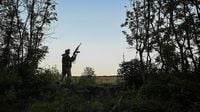On August 14, 2025, a Ukrainian sniper from the elite "Pryvyd" unit achieved what many in the world of military marksmanship once thought impossible: a confirmed kill at a staggering distance of 4,000 meters—over 13,000 feet—setting a new world record for the longest confirmed sniper shot. The news, first reported by the BUTUSOV PLUS telegram channel and widely covered by outlets such as Defense Express, Kyiv Post, and Fox News, has sent ripples through both military and civilian communities, highlighting not only the evolving nature of warfare but also the remarkable capabilities of Ukrainian weaponry and tactics.
The shot, which eliminated two Russian soldiers, was fired from the Pokrovsk–Myrnograd defense direction in eastern Ukraine, a region that has seen intense fighting and increased Russian attacks in recent months. According to Defense Express and Fox News, the sniper used a Ukrainian-made 14.5 mm Snipex Alligator rifle, a weapon manufactured by KhADO Holding in Kharkiv. The rifle, weighing in at 25 kilograms with a barrel length of 1,200 mm, was originally designed as an anti-materiel weapon—intended to target inanimate objects such as equipment or vehicles. Yet, as Defense Express analysts put it, "real life has shown not only completely different requirements, but also the true capabilities of Ukrainian weapons, which have far exceeded the expectations of their creators."
What truly sets this shot apart, beyond its sheer distance, is the sophisticated technology that made it possible. The sniper was aided by a UAV complex—essentially a drone system—combined with artificial intelligence to calculate trajectory corrections. According to military journalist Yuri Butusov, as quoted by the Kyiv Post, "The record-breaking shot was made on Aug. 14, 2025, using artificial intelligence under the guidance of [an unmanned aerial vehicle] complex with a 14.5 mm alligator rifle." This marriage of human skill and technological innovation marks a new chapter in the evolution of sniping, where success at such extreme ranges is no longer a matter of luck, but of precision engineering and digital assistance.
The targets, according to the sources, were indoors—a detail that adds yet another layer of complexity. The bullet passed through a window to reach its mark, demonstrating not just the power of the Alligator rifle but also the meticulous planning and execution by the sniper team. The "Pryvyd" unit, which consists of eight platoons of highly trained snipers from the Ukrainian Ground Forces, has been carrying out combat missions along the Pokrovsk–Myrnograd line. Over the past year alone, these snipers have reportedly eliminated about 1,000 Russian occupiers, underscoring the significant role that long-range marksmanship plays in Ukraine's defense strategy.
For those unfamiliar with the technical challenges involved, achieving a hit at 4,000 meters is nothing short of extraordinary. As Defense Express explains, while the Alligator rifle's bullet can theoretically travel up to 7 kilometers, accuracy becomes a massive hurdle at such distances. At just 1.5 kilometers, the deviation from the target can already reach a circle with a diameter of about one meter. At 4 kilometers, the margin for error is even greater, and experts suggest that it likely took a series of shots to achieve the successful result. "With a lighter rifle, the recoil would be much more noticeable, even considering the muzzle brake and the recoil spring in the stock," Defense Express noted, highlighting the careful balance of weight and stability required for such feats.
The previous record for the longest sniper shot was also held by a Ukrainian. In November 2023, in the Kherson region, a sniper from the SBU unit, Vyacheslav Kovalsky, destroyed an enemy at a distance of 3,800 meters using a Ukrainian rifle called Horizon's Lord (Volodar Obriyu). The fact that both records were set by Ukrainians, using domestically produced rifles, is a point of national pride and a testament to the country’s rapid advancements in military technology under the pressures of ongoing conflict.
Other notable achievements in Ukrainian sniping include a special forces fighter with the call sign "Lector," who set a record by eliminating an enemy at 2,069 meters with a .338LM round. These milestones, while impressive on a technical level, also reflect the increasingly high-stakes environment in which Ukrainian forces operate. Pokrovsk itself, once a city of more than 60,000 residents, has become a focal point of fighting, with Russian attacks intensifying in the area. The ability to strike at such long ranges not only disrupts enemy operations but also serves as a powerful psychological deterrent.
The timing of the record-breaking shot is also notable. It occurred just one day before a closely watched summit between U.S. President Donald Trump and Russian President Vladimir Putin, held on August 15, 2025, at Joint Base Elmendorf-Richardson, Alaska. According to Fox News, Putin described the talks as taking place in a "constructive atmosphere of mutual respect." Meanwhile, Ukrainian President Volodymyr Zelenskyy is scheduled to meet with President Trump in Washington, D.C., on Monday, August 18, 2025, with the stated goal to "discuss all of the details regarding ending the killing and the war," as Zelenskyy posted on X (formerly Twitter).
For Ukraine, this sniper achievement is more than just a record—it’s a symbol of resilience and ingenuity in the face of a much larger adversary. The integration of artificial intelligence and UAV technology into frontline operations is evidence of a broader trend: modern warfare is increasingly being shaped by innovation, adaptability, and a willingness to push the boundaries of what was once thought possible. As the conflict grinds on, such milestones serve as both inspiration for Ukrainian forces and a warning to their opponents that the rules of engagement are changing.
Yet, as with any development in warfare, there are deeper questions to consider. What does it mean for the future of combat when technology can extend the reach of a single soldier to previously unimaginable distances? How will adversaries adapt, and what new ethical or strategic dilemmas will arise as machines and algorithms play a greater role in life-and-death decisions on the battlefield?
For now, the world watches as Ukraine continues to rewrite the record books, one shot at a time. The story of the "Pryvyd" sniper and the 4,000-meter shot is a vivid reminder that even in the darkest of times, innovation and determination can change the course of history—sometimes, with just a single pull of the trigger.




